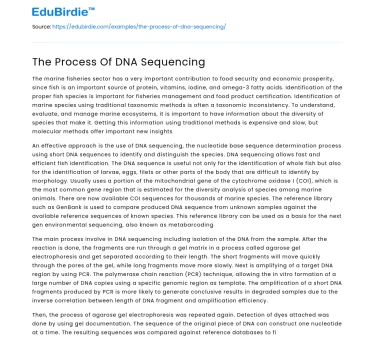The marine fisheries sector has a very important contribution to food security and economic prosperity, since fish is an important source of protein, vitamins, iodine, and omega-3 fatty acids. Identification of the proper fish species is important for fisheries management and food product certification. Identification of marine species using traditional taxonomic methods is often a taxonomic inconsistency. To understand, evaluate, and manage marine ecosystems, it is important to have information about the diversity of species that make it. Getting this information using traditional methods is expensive and slow, but molecular methods offer important new insights
An effective approach is the use of DNA sequencing, the nucleotide base sequence determination process using short DNA sequences to identify and distinguish the species. DNA sequencing allows fast and efficient fish identification. The DNA sequence is useful not only for the identification of whole fish but also for the identification of larvae, eggs, filets or other parts of the body that are difficult to identify by morphology. Usually uses a portion of the mitochondrial gene of the cytochrome oxidase I (COI), which is the most common gene region that is estimated for the diversity analysis of species among marine animals. There are now available COI sequences for thousands of marine species. The reference library such as GenBank is used to compare produced DNA sequence from unknown samples against the available reference sequences of known species. This reference library can be used as a basis for the next gen environmental sequencing, also known as metabarcoding
The main process involve in DNA sequencing including isolation of the DNA from the sample. After the reaction is done, the fragments are run through a gel matrix in a process called agarose gel electrophoresis and get separated according to their length. The short fragments will move quickly through the pores of the gel, while long fragments move more slowly. Next is amplifying of a target DNA region by using PCR. The polymerase chain reaction (PCR) technique, allowing the in vitro formation of a large number of DNA copies using a specific genomic region as template. The amplification of a short DNA fragments produced by PCR is more likely to generate conclusive results in degraded samples due to the inverse correlation between length of DNA fragment and amplification efficiency.
Then, the process of agarose gel electrophoresis was repeated again. Detection of dyes attached was done by using gel documentation. The sequence of the original piece of DNA can construct one nucleotide at a time. The resulting sequences was compared against reference databases to find the matching species.






 Stuck on your essay?
Stuck on your essay?

